Chief II (MCM-14)
1994–
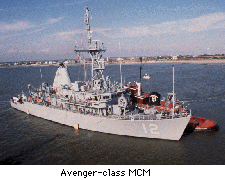
Historic ship name; the head or leader of a group. This is the second ship to bear this name. The first (AM-315) was originally intended for Great Britain, HMS Alice (BAM-2) was launched 5 January 1943 by General Engineering and Dry Dock Co., Alameda, Calif.; renamed and reclassified Chief (AM-315), 23 January 1943; and commissioned 9 October 1943. She was placed out of commission in reserve 17 March 1947. She was re-commissioned on 28 February 1952 for service in Korea. She returned to west coast operations, and on 1 November 1954 was placed in commission in reserve. Reclassified MSF-315 on 7 February 1955, she was placed out of commission in reserve 15 March 1955. Chief received five battle stars for World War II service and two for Korean War service.
The vessels were named for the "head or leader of a group," but not specifically for the chief petty officer rank or grade. Many World War II minesweepers were given the names of positive qualities or words denoting accomplishments.
II
(MCM-14 displacement 1,287 (light), 1,400 (full); length 224'; beam 39'; draft 13'; speed 13.5 knots; complement 84; armament 2 M2HB .50 caliber machine guns; 2 M60, 7.62 millimeter machine guns and 2 Mk19 grenade launchers; class Avenger)
The second Chief (MCM-12) was laid down on 19 August 1991 at Sturgeon Bay, Wisc. by Peterson Builders; launched on 12 June 1993; sponsored by Mrs. Susan Bushey , the wife of , MCPON Duane Bushey the seventh Master Chief Petty Officer of the Navy; and commissioned on 5 November 1994, Lt. Cmdr. Timothy S. Garrold in command.

Coat of Arms
Navy blue and gold are the traditional colors of the United States Navy. The mine in the center of the shield represents the mine countermeasures mission of the Chief while the crossed Officers’ sword and enlisted cutlass symbolize Surface Warfare excellence. The fouled Navy anchor, insignia of a Chief Petty Officer, is further symbolic of the United States Navy’s leadership and commemorates the fact that Chief was launched on 12 June 1993 during the centennial of the Chief Petty Officer Corps. The three silver stars above the fouled anchor depict the leadership and service of the Master Chief Petty Officers of the Navy (MCPON) – past, present and future and honor the ship’s Sponsor.
The stars are also arranged in the same manner about the anchor as the international navigational symbol for lights and shapes about the mast; signifying a vessel engaged in mine clearance operations. There are 84 links in the fouled anchor chain, one for each plank owner, the ship’s sponsor, and the Matron of Honor. The trident atop the crest denotes seapower. The blue and white surface from which it rises represents both the sea, upon which the ship was born.
Surrounding the trident are seven stars representing the seven Battle Stars won during the Second World War and the Korean War by the first ship to bear the name “Chief”, Chief (AM 315), the five above the trident for World War II and the two alongside for the Korean War.
Motto
“HONOR—TRADITION—VALOR"
More than 4,000 people, including a host of chief petty officers, both active and retired, were on hand to note the coincidence of the new ship's name and watch as Chief begin her active Navy career on November 1995, at Naval Amphibious Base Little Creek in Norfolk, Va. The ship is the last of 14 Avenger-class ships.
Chiefs also played an active role throughout the planning and execution of the ceremony. Several chiefs, active and retired, served on the commissioning committee. There was an all-chief petty officer color guard. The ushers were all chiefs. The courtesy vehicles were all driven by chiefs. The band consisted of 52 chief petty officer musicians from across the globe, most of whom travelled at their own expense, just for the chance to participate in the event.
There was also a strong chief presence on the speaker's platform. Every living previous Master Chief Petty Officer of the Navy (MCPON) and the current MCPON, Master Chief Electronics Technician (Surface Warfare) John Hagen, joined the other distinguished guests and speakers.
"Chief. What a great name for a ship," Adm. J. Michael Boorda, Chief of Naval Operations and principal speaker at the ceremony, said. "The very name says it all. The best, number one, a winner in every way. Everyone knows the word leadership and the title of chief go together."
Chief was designed to clear mines from vital waterways. In the early 1980s, the U.S. Navy began development of a new mine countermeasures (MCM) force, which included two new classes of ships and minesweeping helicopters. The vital importance of a state-of-the-art mine countermeasures force was strongly underscored in the Persian Gulf during the eight years of the Iran-Iraq war, and in Operations Desert Shield and Desert Storm in 1990 and 1991 when the Avenger (MCM-1) and Guardian (MCM-5) class ships carried out MCM operations.
Avenger class ships were designed as mine hunter-killers capable of finding, classifying, and destroying moored and bottom mines. The last three MCM ships were purchased in 1990, bringing the total to 14 fully deployable, oceangoing Avenger class ships.
These ships used sonar and video systems, cable cutters, and a mine detonating device that could be released and detonated by remote control. They were also capable of conventional sweeping measures. The ships were of fiberglass sheathed, wooden hull construction, and the first large mine countermeasures ships built in the United States in nearly 27 years.
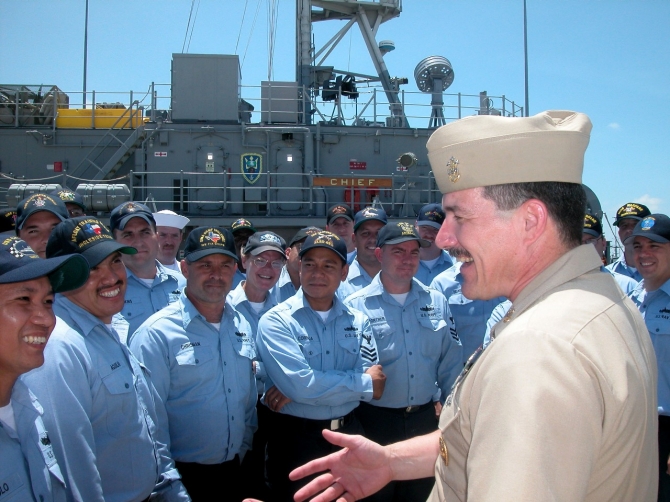
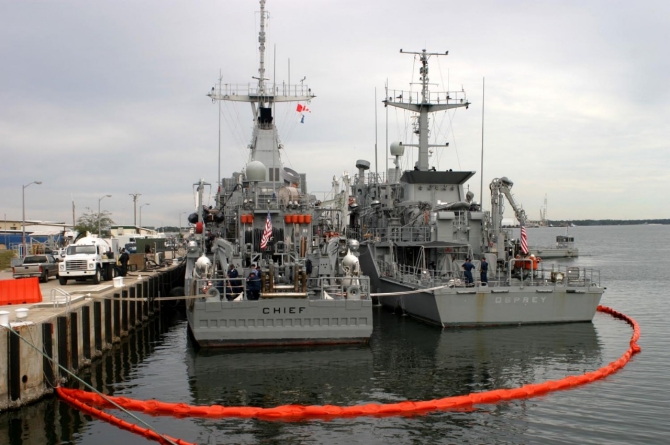
On 17 April 2009 Chief and Warrior (MCM-10) arrived at their new homeport at Naval Base San Diego. Both ships were attached to Commander, Mine Countermeasure Squadron 2. They departed Ingleside, Texas, approximately one month prior for their change of homeport to Naval Base San Diego.
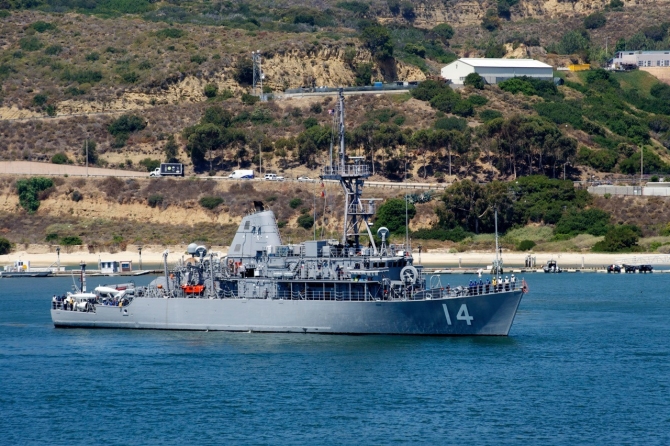
After Chief and Pioneer (MCM-9) were each loaded onto an ocean-going heavy lift ship, both began the transit to their new homeport in Sasebo, Japan, on 31 May 2014. The ships arrived at Sasebo on 3 July.
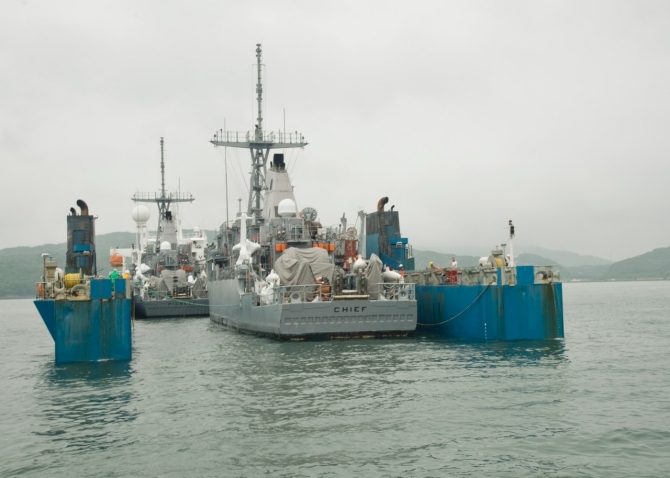
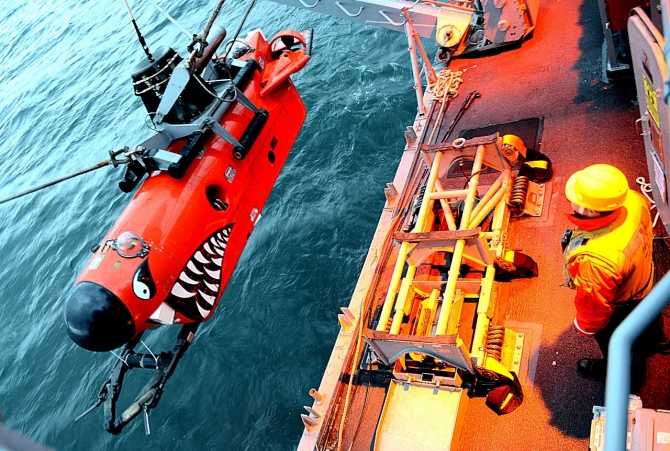
Detailed history pending.
Christopher B. Havern Sr.
16 November 2015


